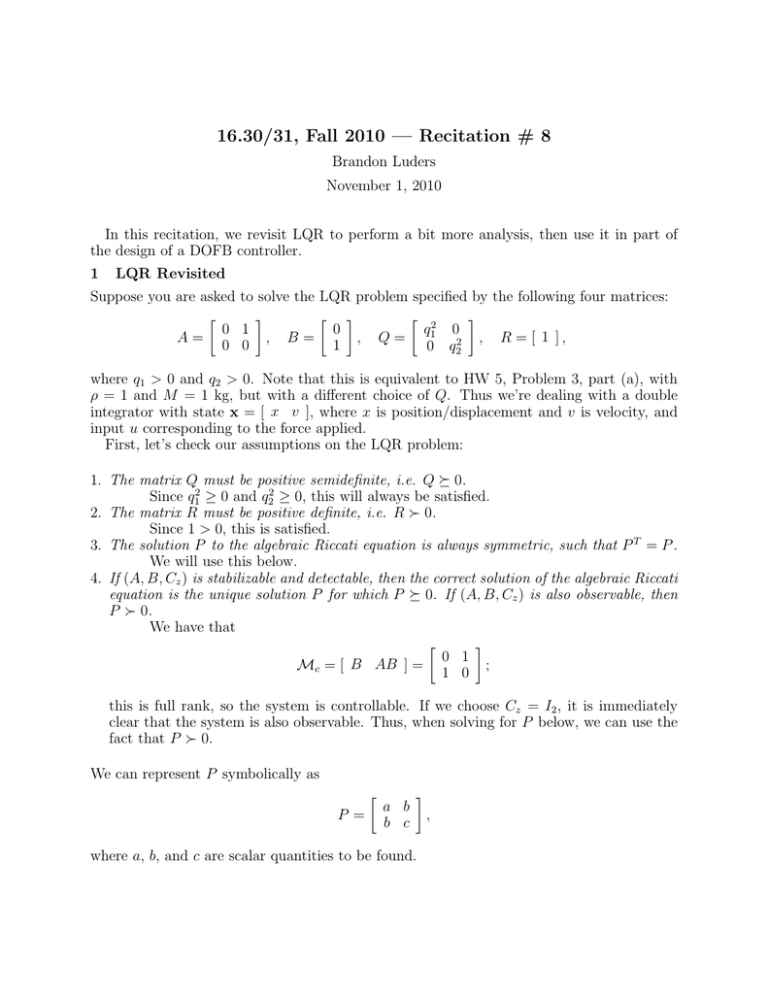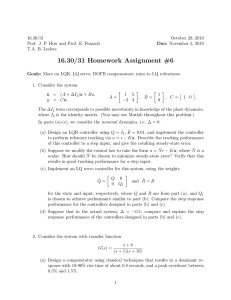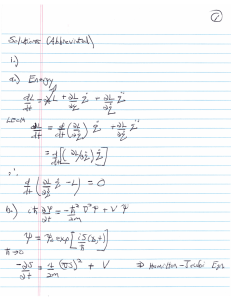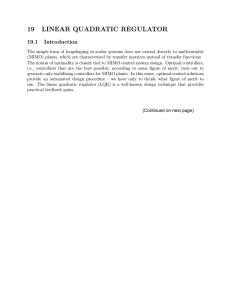Document 13477643
advertisement

16.30/31, Fall 2010 — Recitation # 8 Brandon Luders November 1, 2010 In this recitation, we revisit LQR to perform a bit more analysis, then use it in part of the design of a DOFB controller. 1 LQR Revisited Suppose you are asked to solve the LQR problem specified by the following four matrices: � � � � � 2 � 0 1 0 q 1 0 A = , B = , Q = , R = [ 1 ] , 0 0 1 0 q 22 where q1 > 0 and q2 > 0. Note that this is equivalent to HW 5, Problem 3, part (a), with ρ = 1 and M = 1 kg, but with a different choice of Q. Thus we’re dealing with a double integrator with state x = [ x v ], where x is position/displacement and v is velocity, and input u corresponding to the force applied. First, let’s check our assumptions on the LQR problem: 1. The matrix Q must be positive semidefinite, i.e. Q � 0. Since q 12 ≥ 0 and q 22 ≥ 0, this will always be satisfied. 2. The matrix R must be positive definite, i.e. R � 0. Since 1 > 0, this is satisfied. 3. The solution P to the algebraic Riccati equation is always symmetric, such that P T = P . We will use this below. 4. If (A, B, Cz ) is stabilizable and detectable, then the correct solution of the algebraic Riccati equation is the unique solution P for which P � 0. If (A, B, Cz ) is also observable, then P � 0. We have that � � 0 1 Mc = [ B AB ] = ; 1 0 this is full rank, so the system is controllable. If we choose Cz = I2 , it is immediately clear that the system is also observable. Thus, when solving for P below, we can use the fact that P � 0. We can represent P symbolically as � P = a b b c � where a, b, and c are scalar quantities to be found. , We now plug everything into the algebraic Riccati equation to solve for P : 0 = AT P + P A + Q − P BR−1 B T P � �� � � �� � � 2 � 0 0 a b a b 0 1 q1 0 = + + 1 0 b c b c 0 0 0 q22 � �� � � � a b 0 1 a b − [ 0 1 ] b c 1 1 b c � � � � � 2 � 0 0 0 a q1 0 = + + a b 0 b 0 q22 � �� �� � a b 0 0 a b − b c 0 1 b c � 2 � � �� � q1 a a b 0 0 = − b c b c a 2b + q22 � 2 � � 2 � q1 a b bc = − a 2b + q22 bc c2 � 2 � q 1 − b2 a − bc = . a − bc 2b + q22 − c2 Since this equation is always symmetric, this yields three distinct equations with three un­ knowns (a, b, c): � q12 − b2 = 0 a − bc = 0 2b + q22 − c2 = 0 The first equation is only a function of b, so we can quickly solve it to find that b = ±q1 . Plug this into the third equation: ±2q1 + q22 − c2 = 0 ⇒ c2 = q22 ± 2q1 � ⇒ c = ± q22 ± 2q1 One consquence of Sylvester’s criterion is that for P to be positive definite, all of its diagonal � 2 elements must be positive; thus we need c > 0, implying that c = q2 ± 2q1 . Finally, plug b and c into the second equation: �� � � 2 a = bc = (±q1 ) q2 ± 2q1 = ±q1 q22 ± 2q1 . This yields two possible choices for P : � � � 2 � � � q1 q2 + 2q1 � q1 −q1 q22 − 2q1 � −q1 P = or P = . q1 q22 + 2q1 −q1 q22 − 2q1 Again by Sylvester’s criterion, since q1 > 0, only the first choice is valid; thus � � 2 � q1 q2 + 2q1 � q1 P = . q1 q22 + 2q1 2 We now have all we need to find K: K = R−1 B T P � � 2 � 1 q1 q2 + 2q1 � q1 = [ 0 1 ] 1 q1 q 22 + 2q1 � � � = q1 q22 + 2q1 . We’ve now solved for the LQR feedback K, in terms of q1 and q2 . An important part of analysis for LQR problems is considering how the control would vary if the LQR weights Q and R are modified. For example, for just this simple double integrator we can draw many conclusions: 1. As both q1 and q2 increase, K → [ ∞ ∞ ], reflecting that the relative weight on control effort is shrinking. 2. Conversely, as q1 and q2 → 0, K → [ 0 0 ], since we have that Q → 0 but still R = 1. 3. Suppose q2 is fixed. As q1 increases, both gains increase, but the gain on displacement (the first gain) increases more quickly. In this case, there is a larger penalty on displacement than velocity, so the controller adjusts to cancel displacement more quickly. 4. Suppose q2 is fixed. As q1 → 0, K → [ 0 q2 ]. This is what we call a velocity controller ­ the controller ignores displacement, and merely tries to regulate the velocity back to zero. 5. Suppose q1 is fixed. As q2 increases, only the velocity gain (the second gain) increases. (This is similar to #4 in a relative sense.) � � √ 2q1 . Contrast this with #4 - whereas 6. Suppose q1 is fixed. As q2 → 0, K → q1 velocity can be controlled with a single non-zero gain, both gains are used to regulate the position back to 0. Moving forward, we choose q1 = 8 and q2 = 0, such that K = [ 8 4 ]. Let’s compute the closed-loop poles: � � � � 0 1 0 A − BK = − [ 8 4 ] 0 0 1 � � 0 1 = −8 −4 � � � s −1 � � det(sI − (A − BK)) = �� 8 s + 4 � = s2 + 4s + 8 � √ −4 ± 42 − 4(8) −4 ± −16 s = = = −2 ± 2j 2 2 2 DOFB Compensators Now, consider the system ẋ = Ax + Bu, y = Cx, where A and B are as given in the previous section and C = [ 1 0 ]. This C implies that for this double integrator, we can only measure the displacement, not the velocity. Our objective is to regulate both the system displacement and velocity to 0. 3 Clearly, full-state feedback u = −Kx is not possible for this problem, as only the displace­ ment can be measured. Likewise, it should make sense that feedback of the form u = −Ky is not helpful - it will always apply the same control for the same displacement, regardless of whether the system is stationary or has a huge velocity. Thus, we will need to construct an estimator to develop a system state estimate x̂, then apply feedback of the form u = −Kx̂. For K, we’ll use the LQR controller we designed in the previous section. The closed-loop estimator will take the form x̂˙ = (A − LC)x̂ + Bu + Ly, ŷ = Cx̂, where L is a gain we can choose to place the closed-loop estimator poles appropriately. We know that we can place the eigenvalues of A − LC arbitrarily if (A, C) is observable, something we can easily check: � � � � C 1 0 Mo = = . CA 0 1 Since this is clearly full rank, the system is observable. We are thus free to place the estimator poles anywhere. Using the rule of thumb, we choose poles whose real part is twice those of the regulator poles, i.e. 2(−2) ± 2j = −4 ± 2j. The easiest way to pick L is to simply use the dual of Ackermann’s formula, which gives us the estimator gain yielding the desired closed-loop poles: Φd (s) = (s + 4 − 2j)(s + 4 + 2j) = s2 + 8s + 20 I2 � 0 � � − 1 L = Φd (A) � M�o 1 � �� � 0 0 2 = � A� + 8A + 20I2 1 �� � � �� � � 0 8 20 0 0 = + 0 0 0 20 1 � �� � � � 20 8 0 8 = = . 0 20 1 20 With K and L, we now have everything we need to form the dynamic output feedback (DOFB) compensator necessary to regulate this system: ẋc = Ac xc + Bc y u = −Cc xc Ac = A − BK − LC � � � � � � 0 1 0 8 = − [ 8 4 ]− [ 1 0 ] 0 0 1 20 � � � � � � � � 0 1 0 0 −8 0 −8 1 = + + = 0 0 −8 −4 −20 0 −28 −4 � � 8 Bc = L = 20 Cc = K = [ 8 4 ] 4 We could go ahead and form the closed-loop state space model, but we already know from the separation principle that its poles will be the union of the regulator and estimator poles we have already selected, i.e. −4 ± 2j and −2 ± 2j. To finish things off, let’s perform some analysis of this controller. Write the transfer functions for the plant and controller: Y (s) = C(sI − A)−1 B U (s) � �−1 � � 1 s −1 0 =[ 1 0 ] = 2 0 s 1 s U (s) Gc (s) = = Cc (sI − Ac )−1 Bc E(s) � �−1 � � s + 8 −1 8 =[ 8 4 ] 28 s + 4 20 � �� � 1 s+4 1 8 = 2 [ 8 4 ] −28 s + 8 20 s + 12s + 60 � � 1 144s − 160 8s + 52 = 2 [ 8 4 ] = 2 20s − 64 s + 12s + 60 s + 12s + 60 √ This controller has a zero at −10/9 and poles at −6 ± j 24 - but why? This is not a type of controller (one zero, two complex poles) we considered classically. Yet the root locus shows that this controller places our four closed-loop poles exactly where we wanted them to be: Gp (s) = The zero sucks the two open-loop poles at the origin back into the LHP enough to reach the desired locations, before they head along the asymptotes back into the RHP. Also, note from the Bode plot that the controller does a nice job of adding phase (about 37◦ ) right where it’s needed, at crossover. 5 MIT OpenCourseWare http://ocw.mit.edu 16.30 / 16.31 Feedback Control Systems Fall 2010 For information about citing these materials or our Terms of Use, visit: http://ocw.mit.edu/terms.


